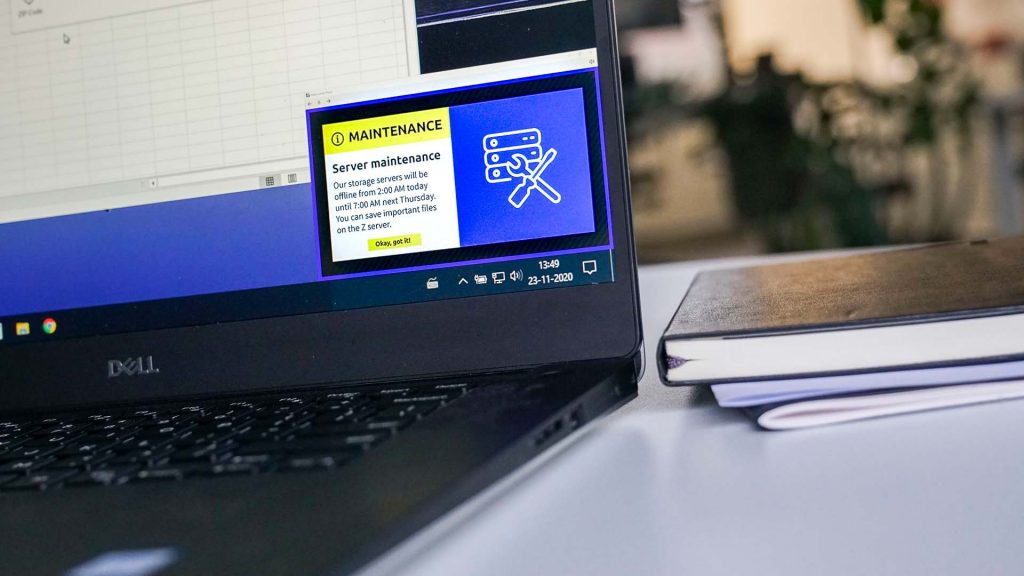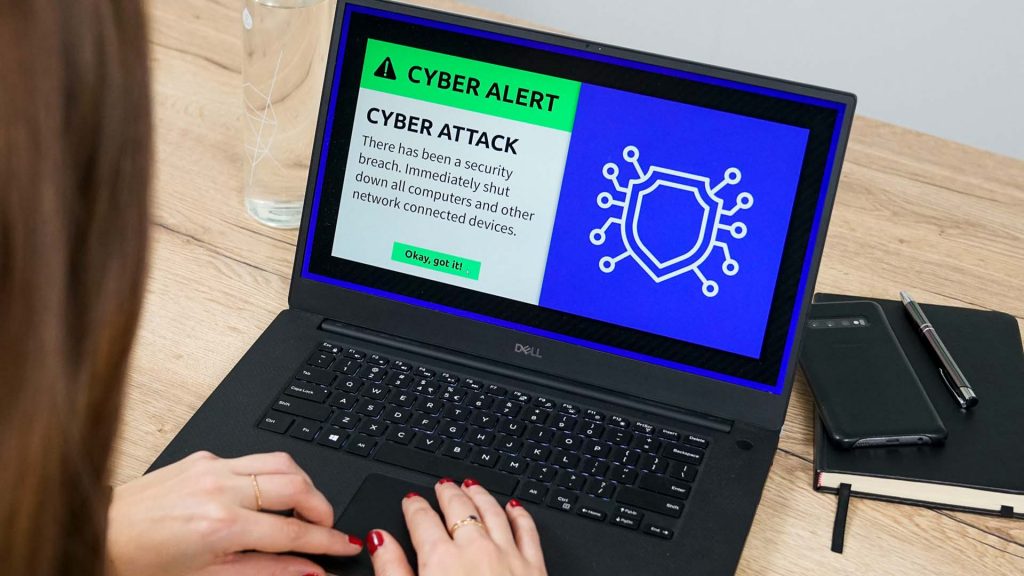How to Use Desktop Alerts to Spread IT Communication
Estimated reading time: 6 minutes
Could you name one organization that operates entirely without IT? Probably not: IT keeps organizations across the globe running. However, outages and downtimes always occur, and maintenance and updates must occur occasionally. This is the cause of a common frustration: failing systems and no information about what’s happened, with heaps of work left to do. Employees need information about their systems to be able to do their job. How do they get that information? With desktop alerts, of course!
Table of contents
What are desktop alerts?
Desktop alerts are notifications that appear on your desktop when you receive a new message, request, or task. They usually pop up in the right lower corner of your computer screen to draw attention – which they do! This makes them an ideal vehicle for important information, something we conveniently use in our Desktop Alert solution.
With our Desktop Alerts, you get maximum visibility for important messages. When you publish a Desktop Alert, your targeted audience group will receive a pop-up notification directly on their desktop screens. High-priority messages will appear on top of the full-screen applications employees are working with at that moment, which means you draw their attention even when they’re busy.
Our Desktop Alerts can appear in your right lower corner or take over the entire screen to ensure staff gets your message. This way, they bypass email entirely to get attention. You can add acknowledgment buttons to ensure that staff has read and acknowledged important messages.
Desktop Alerts and IT communication
Sounds great, right? But how can desktop alerts be used to spread IT communication? Let’s take a look at how you can use our Desktop Alerts solution. Many of our customers already successfully do – you can read their stories here.
Inform about scheduled maintenance
No matter how early you send out an email to notify your colleagues about scheduled maintenance – chances are, they still won’t know about it when the day it’s scheduled finally arrives. Emails can easily be overlooked in today’s workforce’s inboxes. Employees are flooded with emails: in 2020, the average office worker received 121 emails per day.
The total number of daily business and consumer emails sent and received is forecast to grow to more than 347 billion by the end of 2023. So, by 2023, the average worker will probably receive over 121 emails every day. Can’t really blame your colleagues for overlooking certain emails…
With desktop alerts, your colleagues will always be aware of scheduled maintenance as they can’t be overlooked and completely bypass email. They pop up on top of other applications being used at that moment and can have an acknowledgment button, so you’re genuinely sure they have read the information. No more surprises for your colleagues!

Inform about unscheduled downtimes or outages
Our customers gratefully use our Desktop Alerts to inform their staff about unscheduled downtimes or outages. Whenever there’s downtime of any of their systems, they quickly publish an alert because they feel they can be sure everybody gets it.
The alerts allow organizations to have direct critical communication with their employees when they need it. They will help them understand what’s going on, can tell them where to go for additional information about the current states of their systems, and will keep them updated throughout the downtime.
When the systems are back up, they can also be used to inform everyone that their system has been restored. Our healthcare customers, especially, love to use our Desktop Alerts to reach employees who can’t otherwise be reached immediately. For example, clinical staff who don’t have access to overhead announcements or email. Read their stories to find out how they are using our Desktop Alerts.
Reduce email overload
Remember the number of emails an average office worker receives daily? Well, with our Desktop Alerts, you can reduce that number for your employees! Instead of an email that will only get lost in your employees’ inboxes, you send an Alert for urgent matters. We’re not claiming you won’t use email anymore, but we’re pretty confident your employees will read the message in your Desktop Alert (they otherwise wouldn’t have read it if it was an email).
Improve cybersecurity awareness
Desktop Alerts can be quickly sent when there is a threat to your organization’s cybersecurity. You can provide immediate instructions on what employees must do to help avoid a cyberattack. For example, did one of your colleagues receive an email that looks like your CEO (who knows nothing about said email) sent it? You can easily and quickly inform your complete staff and tell them not to open the email by distributing a Desktop Alert with instructions.
You can also target certain employees who may need reminders about cybersecurity protocols in your organization to help your organization’s digital infrastructure stay safe and secure. With an acknowledgment button, you can track who has and hasn’t read your message and who may need some new reminders.

Inform in case of a cyber attack
In case of an active cyberattack, you want to be able to act quickly and get a message out safely to all staff. A quick and safe way to briefly inform people of what’s going on and how to act is by sending a Desktop Alert. It will pop up on top of other applications and can have any instructions you would like.
We appreciate that staff needs more explanation than any desktop alert can convey in case of a real cyber attack. However, it will definitely help to inform your staff, all at once and wherever they are, that something is going on. It also enables you to include information about where staff will be given more instructions and explanations. Our attention boosters will automatically retarget anyone who hasn’t yet read or acknowledged your message until they do, so you can be sure everyone will quickly be informed.
Do you think your organization could use Desktop Alerts? We certainly do! Get in touch with our consultants or schedule a free 30-minute demo; they are happy to show you what our Desktop Alerts and our platform can offer for your organization. Or download our free infographic the power of push notifications.

What are Netpresenter Desktop Alerts?
Netpresenter Desktop Alerts are real-time notifications that appear directly on the computer screens of employees. They are designed to deliver important messages immediately, ensuring that critical information reaches users without delay. These alerts can include text, images, links, and even videos, and they are typically used for urgent communications like emergency notifications or important updates from management.
What types of messages can be sent with Netpresenter Alerts?
It is versatile and can be used to send a wide range of message types. These include emergency notifications, such as fire alarms or severe weather warnings, IT system outages, health and safety updates, event reminders, and important company announcements. The system’s flexibility allows it to cater to both urgent messages that require immediate attention and routine communications that are part of everyday business operations. This makes it an invaluable tool for maintaining effective communication within any organization, regardless of the type of information being disseminated.
What are the system requirements for Desktop Alerts?
Visit our support center to download the system requirements and other tech sheets of Desktop Alerts.
How do I measure the effectiveness of Netpresenter Alerts?
Measuring the effectiveness is straightforward thanks to its detailed analytics and reporting features. The platform allows you to track a variety of metrics, such as message delivery status, open rates, and click-through rates. These insights enable you to assess how well they are performing and whether they are reaching and engaging the intended audience. By analyzing this data, you can identify areas for improvement and make necessary adjustments to enhance the impact of your communications. This continuous feedback loop ensures that your messaging remains effective and that your employees stay informed.
Can Netpresenter Desktop Alerts be stopped by pop-up blockers?
No, Netpresenter Desktop Alerts are not affected by pop-up blockers. Unlike standard web-based pop-ups, Netpresenter alerts are delivered through a dedicated application that runs on employees’ computers. This ensures that alerts will appear regardless of web browser settings or any pop-up blocking software that may be installed.
Can I schedule Desktop Alerts to be sent at specific times?
Yes, publishers can schedule Netpresenter Desktop Alerts to be sent at specific times. This feature is particularly useful for planning announcements or reminders that need to be delivered at a precise moment. For example, you can schedule IT-related updates, such as server maintenance, in advance and make timely announcements. By setting the date and time for the alert to go live, you ensure your message reaches the audience exactly when intended.
Do I need to schedule a demo to try Netpresenter?
No need to wait for a live demo — just take the self-guided tour at your convenience. It’s quick, clear, and available 24/7.
When should I take a Guided Tour instead of requesting a demo?
A Guided Tour is ideal when:
- You want a quick, on-demand overview without scheduling a meeting.
- You are early in the decision-making process and exploring solutions.
- You want to share an internal preview of the software with colleagues or stakeholders.
Or schedule a personalized free 30-minute demo with one of our consultants to discover the power of our platform. They would love to show you everything Netpresenter has to offer.
